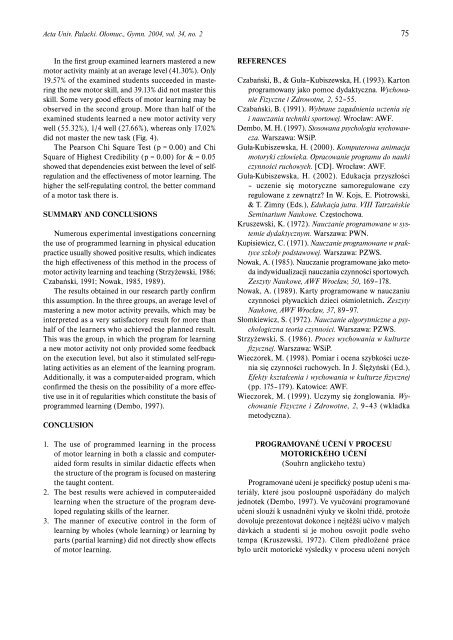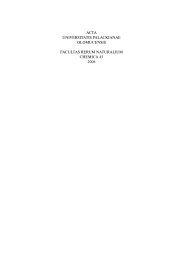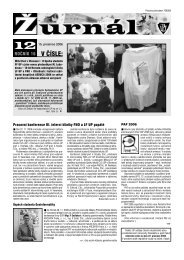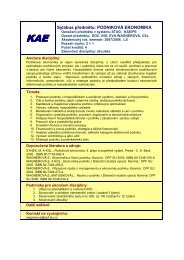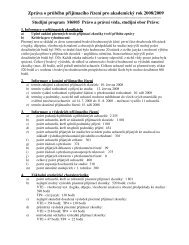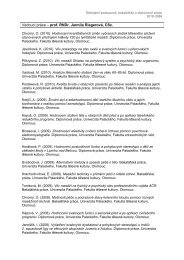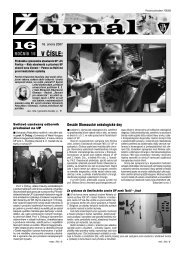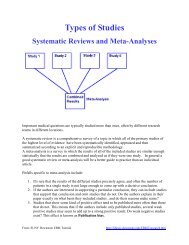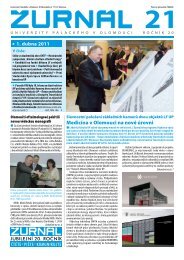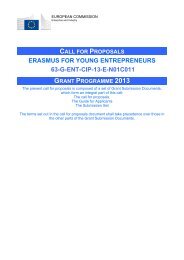ACTA UNIVERSITATIS PALACKIANAE OLOMUCENSIS GYMNICA ...
ACTA UNIVERSITATIS PALACKIANAE OLOMUCENSIS GYMNICA ...
ACTA UNIVERSITATIS PALACKIANAE OLOMUCENSIS GYMNICA ...
- No tags were found...
You also want an ePaper? Increase the reach of your titles
YUMPU automatically turns print PDFs into web optimized ePapers that Google loves.
Acta Univ. Palacki. Olomuc., Gymn. 2004, vol. 34, no. 2 75In the first group examined learners mastered a newmotor activity mainly at an average level (41.30%). Only19.57% of the examined students succeeded in masteringthe new motor skill, and 39.13% did not master thisskill. Some very good effects of motor learning may beobserved in the second group. More than half of theexamined students learned a new motor activity verywell (55.32%), 1/4 well (27.66%), whereas only 17.02%did not master the new task (Fig. 4).The Pearson Chi Square Test (p = 0.00) and ChiSquare of Highest Credibility (p = 0.00) for & = 0.05showed that dependencies exist between the level of selfregulationand the effectiveness of motor learning. Thehigher the self-regulating control, the better commandof a motor task there is.SUMMARY AND CONCLUSIONSNumerous experimental investigations concerningthe use of programmed learning in physical educationpractice usually showed positive results, which indicatesthe high effectiveness of this method in the process ofmotor activity learning and teaching (Strzyżewski, 1986;Czabański, 1991; Nowak, 1985, 1989).The results obtained in our research partly confirmthis assumption. In the three groups, an average level ofmastering a new motor activity prevails, which may beinterpreted as a very satisfactory result for more thanhalf of the learners who achieved the planned result.This was the group, in which the program for learninga new motor activity not only provided some feedbackon the execution level, but also it stimulated self-regulatingactivities as an element of the learning program.Additionally, it was a computer-aided program, whichconfirmed the thesis on the possibility of a more effectiveuse in it of regularities which constitute the basis ofprogrammed learning (Dembo, 1997).CONCLUSION1. The use of programmed learning in the processof motor learning in both a classic and computeraidedform results in similar didactic effects whenthe structure of the program is focused on masteringthe taught content.2. The best results were achieved in computer-aidedlearning when the structure of the program developedregulating skills of the learner.3. The manner of executive control in the form oflearning by wholes (whole learning) or learning byparts (partial learning) did not directly show effectsof motor learning.REFERENCESCzabański, B., & Guła–Kubiszewska, H. (1993). Kartonprogramowany jako pomoc dydaktyczna. WychowanieFizyczne i Zdrowotne, 2, 52–55.Czabański, B. (1991). Wybrane zagadnienia uczenia sięi nauczania techniki sportowej. Wrocław: AWF.Dembo, M. H. (1997). Stosowana psychologia wychowawcza.Warszawa: WSiP.Guła-Kubiszewska, H. (2000). Komputerowa animacjamotoryki człowieka. Opracowanie programu do naukiczynności ruchowych. [CD]. Wrocław: AWF.Guła-Kubiszewska, H. (2002). Edukacja przyszłości– uczenie się motoryczne samoregulowane czyregulowane z zewnątrz? In W. Kojs, E. Piotrowski,& T. Zimny (Eds.), Edukacja jutra. VIII TatrzańskieSeminarium Naukowe. Częstochowa.Kruszewski, K. (1972). Nauczanie programowane w systemiedydaktycznym. Warszawa: PWN.Kupisiewicz, C. (1971). Nauczanie programowane w praktyceszkoły podstawowej. Warszawa: PZWS.Nowak, A. (1985). Nauczanie programowane jako metodaindywidualizacji nauczania czynności sportowych.Zeszyty Naukowe, AWF Wrocław, 50, 169–178.Nowak, A. (1989). Karty programowane w nauczaniuczynności pływackich dzieci ośmioletnich. ZeszytyNaukowe, AWF Wrocław, 37, 89–97.Słomkiewicz, S. (1972). Nauczanie algorytmiczne a psychologicznateoria czynności. Warszawa: PZWS.Strzyżewski, S. (1986). Proces wychowania w kulturzefizycznej. Warszawa: WSiP.Wieczorek, M. (1998). Pomiar i ocena szybkości uczeniasię czynności ruchowych. In J. Ślężyński (Ed.),Efekty kształcenia i wychowania w kulturze fi zycznej(pp. 175–179). Katowice: AWF.Wieczorek, M. (1999). Uczymy się żonglowania. WychowanieFizyczne i Zdrowotne, 2, 9–43 (wkładkametodyczna).PROGRAMOVANÉ UČENÍ V PROCESUMOTORICKÉHO UČENÍ(Souhrn anglického textu)Programované učení je specifický postup učení s materiály,které jsou posloupně uspořádány do malýchjednotek (Dembo, 1997). Ve vyučování programovanéučení slouží k usnadnění výuky ve školní třídě, protožedovoluje prezentovat dokonce i nejtěžší učivo v malýchdávkách a studenti si je mohou osvojit podle svéhotempa (Kruszewski, 1972). Cílem předložené prácebylo určit motorické výsledky v procesu učení nových


